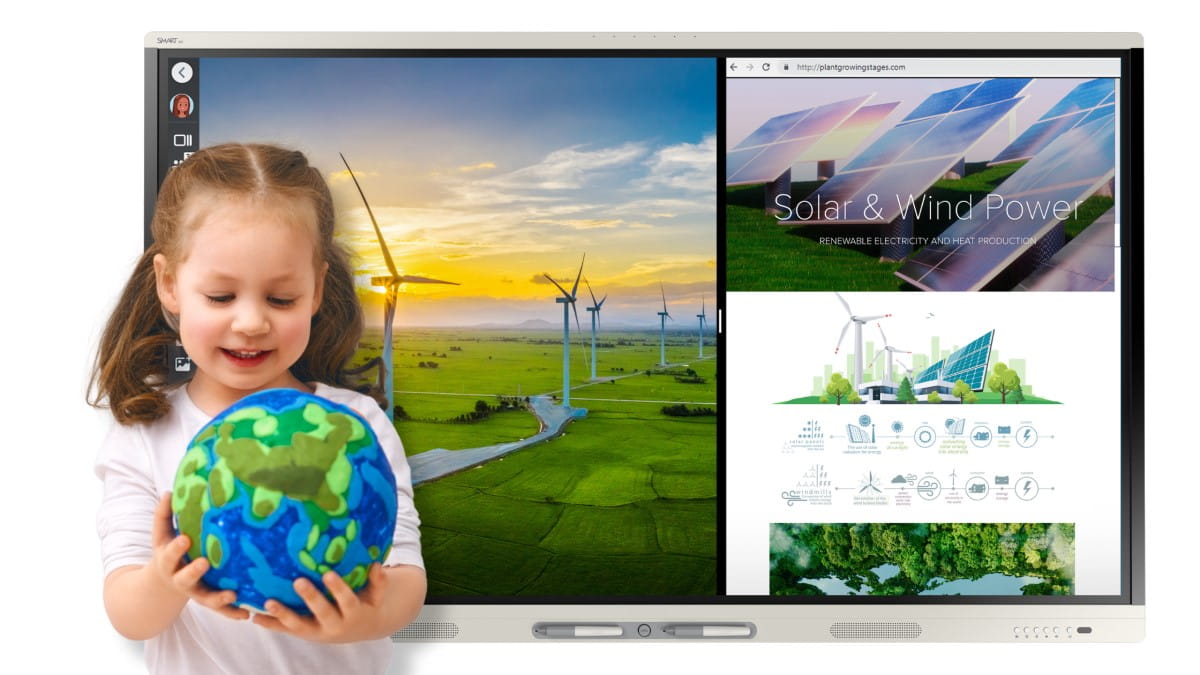With Earth Day approaching, we’re reminded of the importance that sustainability plays in the technology landscape. April 22nd marks the 54th annual Earth Day—a day dedicated to celebrating the planet and supporting environmental action, together.
The theme for Earth Day 2024 is Planet vs. Plastics, uniting students, businesses, governments and individuals in an undeniable mission to end plastic pollution for good. At SMART, we consider the carbon footprint of the product from design all the way to shipping and delivery. SMART displays come in recyclable packaging that has been optimized and redesigned to use less materials and to fit up to 30% more displays onto pallets and into shipping containers. It is the slimmest packaging on the market, limits the need for single-use plastics, and all without compromising the safety of your investment.
We recognize that technology manufacturers have an opportunity to make a large impact on the environment. That’s why sustainability isn’t just a buzzword to us. It’s a long-term commitment to shaping the way we design and interact with technology. From manufacturing to packaging, distribution to usage, our products are designed and built with the environment in mind.
This Earth Day, we’re encouraging everyone to dig deeper into sustainability and investing in our planet. When looking at EdTech providers, here are a few questions to ask yourself to ensure you consider the environmental impact of your technology:
- What materials are used in the construction of the interactive display, and are they environmentally friendly or recyclable?
- How does the company approach in-house hardware design and engineering to ensure quality, reliability, and sustainability?
- Does the interactive display have energy-saving features, such as automatic power-off or energy-efficient LED backlighting?
- How does the interactive display contribute to reducing overall energy consumption in the environment, considering its usage patterns and power requirements?
- How much should I expect to spend to power the display?
- Is the interactive display certified by reputable environmental standards, such as Energy Star or EPEAT, indicating its eco-friendliness?
- Does the manufacturer have a transparent sustainability policy or commitment, including initiatives to reduce their carbon footprint, minimize waste, or support environmental causes?
- How does the interactive display support sustainable practices in educational or business settings, such as facilitating paperless workflows or reducing reliance on disposable materials?
It’s also important to consider longevity when we speak about sustainable technology. Here’s a list of questions you can ask when evaluating technology that will stand the test of time:
- What measures does the company take to ensure the longevity of its technology products from design to end-of-life sustainability?
- Are the products designed to be upgradeable and repairable, thus reducing the need for frequent replacements?
- Does the company offer features like over-the-air updates to extend the lifespan of their technology products?
- What kind of rigorous testing, such as Accelerated Life Testing, do the products undergo to ensure durability and reliability?
- How does the company prioritize ethical production practices, including sourcing components from suppliers that uphold human rights, ethics, and environmental responsibility?
- How does the company foster innovation through technology longevity, ensuring that investments in new software or technology can be utilized and built upon for years to come?
We are committed to sourcing components and materials from companies that share our values on human rights, ethics, and environmental responsibility. We are diligent about working with suppliers that source conflict-free minerals. Beyond that, we’re actively using more sustainable methods of manufacturing.
For instance, the SMART Board MX V4 is manufactured with 100% renewable (solar!) energy. You can feel good about where your product is coming from and how it was made.
SMART displays have a seriously long lifespan. We test our displays for up to 50,000 hours of usage - that’s over 10 years of use! We design our displays to support over-the-air updates and upgradable computing modules that make a huge difference in the longevity of your displays. The result is fewer product replacements, less e-waste, and better functionality long-term.
Plus, we design our boards to minimize power consumption, resulting in more dollars in your pocket.
So, join us on our mission to invest in our planet while striving for innovation. Sustainability is one of our guiding principles here at SMART and will continue to be on our path to Net Zero. Learn more about our ongoing commitment to sustainability and longevity here:


